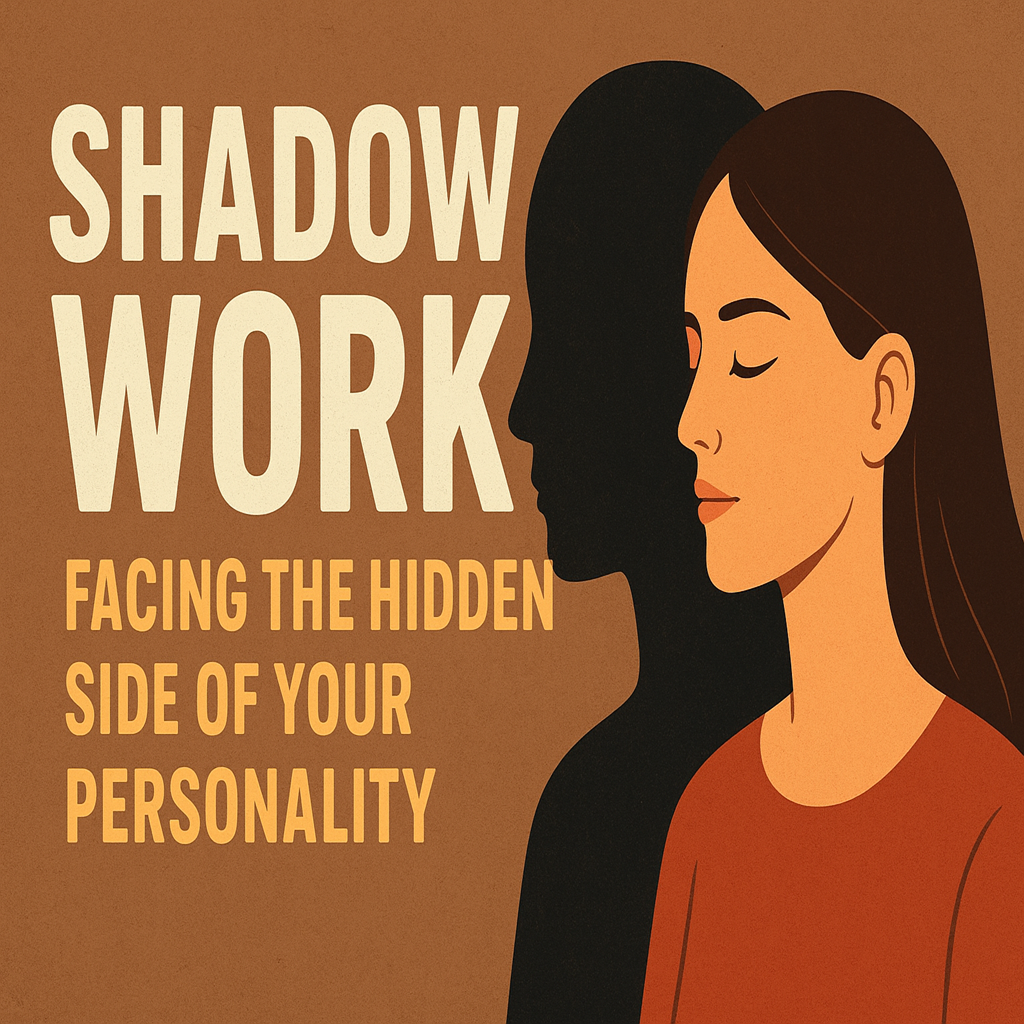
Shadow Work: Facing the Hidden Side of Your Personality
Every human being carries light and darkness within them. While we often like to showcase our positive traits—kindness, confidence, ambition—we tend to hide the aspects of ourselves that feel shameful, negative, or socially unacceptable. Psychologists call this hidden part of the self the “shadow.”
The concept of the shadow was introduced by Carl Gustav Jung, the Swiss psychiatrist and psychoanalyst, who believed that the shadow contains the parts of our personality that we suppress, deny, or ignore. These can be impulses, fears, weaknesses, desires, or even strengths that we do not consciously acknowledge.
Shadow work is the process of bringing these hidden elements into awareness, facing them without judgment, and integrating them into a healthier sense of self. Far from being just a mystical or spiritual practice, shadow work has deep psychological roots and offers a path to greater self-awareness, emotional healing, and authentic living.
In this article, we will explore the science, psychology, and practices behind shadow work, uncovering why facing the hidden side of your personality is one of the most transformative journeys you can take.
The Origins of the Shadow
Carl Jung described the shadow as “the thing a person has no wish to be.” It is formed in childhood, when we first start learning what is acceptable and what is not. For example:
- A child who is naturally loud and expressive may be told, “Don’t be so noisy!” Over time, they suppress their enthusiasm and grow quieter.
- A child who cries easily may be told, “Stop being weak!” They may learn to hide vulnerability.
- A child with artistic dreams may hear, “That’s not practical, focus on real work!” and so creativity gets buried.
Over the years, these suppressed traits do not disappear. Instead, they get stored in the unconscious mind, forming the shadow.
The shadow is not inherently negative—it simply represents the hidden, repressed, and unacknowledged Iaspects of ourselves. Some of those parts are destructive, like anger or jealousy, but others may be powerful and positive traits we have buried because of fear or conditioning.
Learn more about Therapeutic Interventions and how can How to heal your past life trauma?
Why the Shadow Matters
Ignoring the shadow does not make it disappear. In fact, the shadow often leaks out unconsciously in destructive ways:
- Projection:We dislike traits in others that we secretly suppress in ourselves. For example, someone who denies their own selfishness might constantly accuse others of being selfish.
- Triggers:Overreactions to small events often reveal hidden wounds from the shadow.
- Sabotage:Unacknowledged beliefs, like “I am unworthy,” can block success or healthy relationships.
- Addictions and compulsions:Hidden pain often manifests in unhealthy coping mechanisms.
Facing the shadow helps us reclaim our wholeness. Instead of being controlled by unconscious patterns, we consciously acknowledge and integrate them.
The Psychology of Shadow Work
Other branches of psychology also support shadow work:
- Other branches of psychology also support shadow work:
- Freud’s Psychoanalysis:Freud described the unconscious mind as a reservoir of repressed desires. Shadow work aligns with his idea of uncovering hidden drives.
- Modern Cognitive Psychology:Our behavior is shaped by unconscious biases, beliefs, and schemas. Shadow work uncovers these hidden mental programs.
- Humanistic Psychology:Thinkers like Carl Rogers emphasized accepting all parts of ourselves with unconditional positive regard. Shadow work reflects this acceptance.
- Trauma Psychology:Suppressed childhood wounds often form the shadow. By facing these wounds, we allow healing and integration.
Thus, shadow work blends both spiritual insight and psychological science, making it a bridge between therapy and inner transformation.
Signs Your Shadow Needs Attention
Everyone has a shadow, but certain patterns indicate it is actively controlling your life:
- You get easily triggered by other people’s behaviors.
- You constantly judge or criticize others.
- You struggle with repeated negative relationship patterns.
- You feel inauthentic, as though wearing a mask in public.
- You experience deep shame or guilt about parts of yourself.
- You suppress emotions like anger, sadness, or jealousy.
- You self-sabotage when opportunities arise.
If these resonate, shadow work can help you uncover the hidden roots behind them.
The Benefits of Shadow Work
Shadow work may feel uncomfortable at first, but it offers profound benefits:
1. Self-Awareness
You gain clarity about your hidden motivations and triggers.
2. Emotional Healing
Old wounds lose their power when they are acknowledged.
3. Healthier Relationships
By owning your shadow, you stop projecting onto others and create deeper, more authentic bonds.
4. Personal Growth
Embracing all of yourself unlocks creativity, resilience, and authenticity.
5. Inner Freedom
Instead of being ruled by unconscious fears, you consciously choose your actions.
How to Practice Shadow WorK
Shadow work is not about fighting the shadow—it’s about accepting, listening, and integrating. Here are practical methods:
1. Journaling the Shadow
Write down moments when you felt triggered or judged someone harshly. Ask yourself: What does this reflect about me?
2. Mirror Work
Stand in front of a mirror, look into your eyes, and speak honestly. Admit qualities you hide. For example: “I feel jealous. I often hide my anger. I sometimes feel unworthy.”
3. Inner Dialogue
Imagine speaking directly with your shadow as if it were a character. Ask: What do you want me to know? Why are you here?
4. Meditation & Visualization
Sit quietly, visualize meeting your shadow in a safe space, and allow suppressed feelings to rise without judgment.
5. Noticing Projections
When someone irritates you, instead of blaming them, ask: What is this reflecting about me that I don’t want to admit?
6. Creative Expression
Use art, music, or writing to express hidden parts of yourself without censorship.
7. Therapeutic Guidance
Sometimes the shadow contains deep trauma. Working with a therapist trained in Jungian psychology, trauma therapy, or Internal Family Systems (IFS) can provide safety and insight.
Examples of Shadow Work in Daily Life
1. The Angry Professional
A man suppresses his anger to appear professional. But at home, he explodes at small things. Shadow work helps him admit his anger, express it safely, and resolve its root cause.
2. The “Good Girl” Syndrome
A woman prides herself on being nice and helpful. But she secretly resents others. By facing her shadow, she learns to set healthy boundaries and honor her needs.
3. The Perfectionist
Someone obsessed with success hides their fear of failure. Shadow work helps them accept imperfection and live with more balance.
Common Myths About Shadow Work
1. “It’s dangerous.”
Shadow work is not about indulging negativity but about integrating hidden parts with compassion.
2. “Only spiritual people need it.”
Everyone has a shadow. It’s a psychological process, not limited to spirituality.
3. “It’s about becoming perfect.”
Shadow work is about wholeness, not perfection.
4. “It’s too dark.”
The shadow also hides positive qualities like creativity, confidence, and power that were repressed.
Shadow Work and Relationships
Relationships are powerful mirrors of our shadow. The traits we deny in ourselves often appear in our partners, friends, or colleagues. For example:
- If you suppress anger, you may attract people who express it openly.
- If you hide your neediness, you may be triggered by others who seek constant attention.
By working on your shadow, you stop blaming others and instead see relationships as opportunities for self-growth.
The Spiritual Dimension
Our collective culture also has a shadow. Social issues such as discrimination, greed, and violence reflect the unacknowledged shadow of humanity. Shadow work at an individual level can ripple into collective healing.
The rise of social media also highlights shadow dynamics. Online trolling, cancel culture, and envy are modern expressions of collective shadow projections. By acknowledging these, society can work toward more conscious digital behavior.
The Shadow in Modern Society
In spiritual traditions, facing the shadow is often described as entering the “dark night of the soul.” Instead of avoiding darkness, seekers embrace it to uncover deeper light within. Shadow work therefore becomes not just a psychological tool, but a spiritual journey toward unity and inner peace.
Practical Tips for Safe Shadow Work
- Begin slowly; do not overwhelm yourself with all repressed emotions at once.
- Practice self-compassion—remind yourself that having a shadow is part of being human.
- Set boundaries: if something feels too heavy, take a break.
- Consider guidance from therapy, coaches, or support groups if deep trauma surfaces.
Conclusion
Shadow work is not about erasing darkness but about integrating it into the light of consciousness. As Carl Jung said:
“One does not become enlightened by imagining figures of light, but by making the darkness conscious.”
When you face your hidden fears, wounds, and suppressed desires, you reclaim your authenticity. Instead of being divided between the person you show the world and the person you secretly are, you become whole.
By practicing shadow work, you discover that the shadow is not your enemy but your teacher—guiding you toward self-awareness, healing, and freedom.

